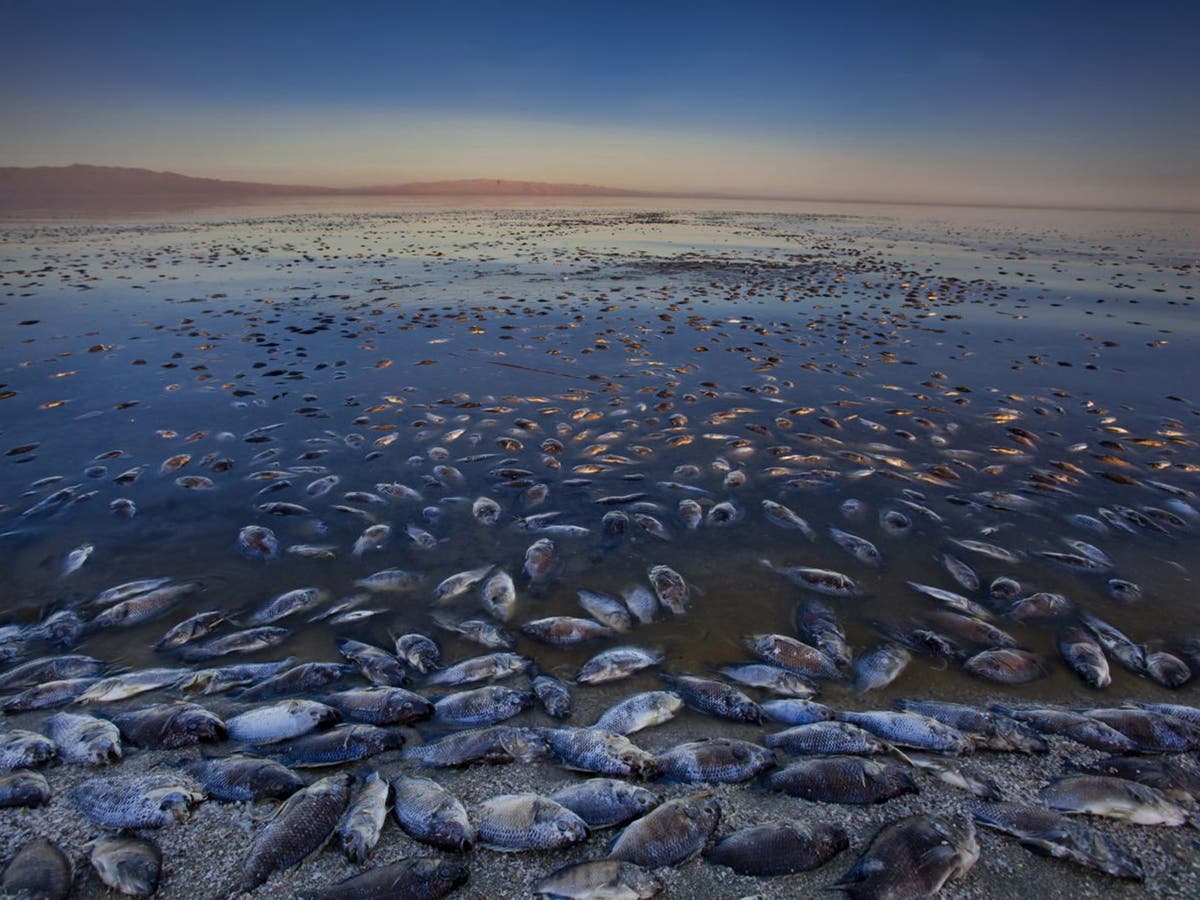An essential reflection on the emerging environmental threat of going away saline lakes and possible impacts on youngsters’
health and wellness Altering weather condition patterns, droughts and contending water demands are dramatically altering the landscape and creating conditions conducive to the production of wind-blown dirt and black blizzard. In The golden state, such elements are bring about the rapid shrinking of the Salton Sea, a 345 square mile land-locked sea located near the southeastern country border region referred to as the Imperial Valley. The area is anticipated to experience a significant increase in wind-blown dirt and existing research studies recommend a significant impact on the health and quality of life for nearby residents of this predominantly low-income, Mexican-American community. The conversation calls attention to the public health measurements of the Salton Sea dilemma.read about it What Is Super 6 Casino Game from Our Articles We understand little regarding the feasible long-term health impacts of direct exposure to activated lakebed sediments or the various toxic impurities that might come to be respirable on entrained particles. We draw on existing epidemiological literature of various other well-known sources of wind-blown dirt, such as desert black blizzard, and associated wellness impacts to start to understand the potential public health influence of wind-blown dirt exposure. The boosted production of wind-blown dirt and ecological direct exposures to such non-combustion related resources of particle issue are a growing health hazard, due partly to drought coupled with enhancing pressures on restricted water sources. Recent population-based research studies have connected dust storms with cardiovascular mortality, bronchial asthma hospitalization and lower in pulmonary function in both adults and youngsters. A growing number of studies provide evidence of the intense wellness effects of wind-blown dirt direct exposures among children, which with repeated insults have the potential to affect breathing wellness over time. The shrinking of the Salton Sea illustrates a public health and environmental justice situation that calls for activity and attention to shield the health and wellness and wellness of regional neighborhoods.
A brief history of Salton Sea
Climate modification is forecasted to bring increasingly hotter and drier problems to much of the Southwestern USA (United States), creating conditions for the boosted manufacturing of wind-blown dust (Pu and Ginoux 2017). These factors, paired with drought and contending water demands, have laid the ground for a human health and wellness and eco-friendly disaster-in-the-making in the southeastern border area of California (CA), referred to as the Imperial Valley. The Salton Sea, a 345-square-mile shallow land-locked sea located in the northern part of Imperial Valley, was created unintentionally throughout diversion of the Colorado River in the early 1900s loading a completely dry salt bed (Figure 1). This superficial terminal lake, which is 35 miles long, 15 miles vast and only approximately 20 feet deep, has actually been maintained in this arid desert climate largely by watering runoff from nearby farming lands. The Sea basically serves as a database for irrigation wastewaters, which traditionally have made up over 95% of the annual water inflows (Hart et al. 1998; Tompson 2016).
The Imperial Valley, which surrounds the Salton Sea’s southerly coasts, is an extremely productive agricultural region that depends on water imported from the Colorado River. The Imperial Watering District (IID), which gives water to the agricultural sector in Imperial Valley, has actually historically held the single largest entitlement to freshwater from the Colorado River of any Colorado River make use of. Water for the Imperial Valley is diverted from the Colorado River into the All-American Canal, a human-made watering network along the Mexico/California border. Via a considerable network of canals and ditches, approximately 3.2 billion cubic meters of Colorado River water is delivered to over 2,000 square kilometers of Imperial Valley farming land annually, although this number is expected to decrease in coming years. In 2003, a federally bought Metrology Negotiation Contract (QSA) stated a decrease of Colorado River water imports to the Imperial Valley, to increase water sources for growing city areas. As part of the negotiations, 15 years of reduction water was assigned to the Sea to give time for the state to deal with the influences of a diminishing Sea, because of the expected reduction in farming watering overflow. The role of water in preserving the environmental and economic vitality of the Salton Sea was not viewed as a direct beneficial use within the water reapportionment (Cantor 2016). Therefore, since December 2017, almost fifty percent of all freshwater streaming into the land-locked Salton Sea has actually been drawn away for mostly urban uses as part of this negotiation, speeding up the quick diminishing of the biggest inland water body in CA (King et al. 2011; Tompson 2016).
A situation in slow motion: Vanishing seas and air contamination
The Salton Sea has been shrinking gradually for several years (Barnum et al. 2017). Given the surrounding desert climate and shallowness of the Sea, big swaths of the seabed have and will certainly continue to come to be subjected as the water levels decline. The pulling away coastline leaves subjected playa which has the prospective to create dirt that is easily set in motion by strong winds in the location from the huge salt flats (King et al. 2011) (Number 2). A design from the US Geological Survey approximated that the decrease of 3 feet in elevation will reveal over 11,000 acres of saline lakebed sediment (Case et al. 2013). A different research forecasts that fugitive wind-blown dust could increase by as much as 40 to 80 tons each day after water inflows are minimized in 2018 and the lake will certainly reduce by about 100 square miles by 2030 (Cohen and Hyun 2006). Previous research suggests that these salt-based crusts are currently a significant resource of dirt discharges and predicts that the playa is most likely to end up being an increasingly crucial source of respirable particle matter <<10 μmu; m in size (PM10)in the region (King et al. 2011). Before the water transfer, about 10 % of PM10 in the region was attributable to playa-like soils, a payment that is approximated to enhance during high wind events (Frie et al. 2017).
A Sea sustained by commercial farming leaves a toxic tradition
Agricultural irrigation drainage water streams right into the Alamo and New Rivers or with discharge canals, which consequently, circulation north and discharge into the Salton Sea (De Vlaming et al. 2004). This irrigation drainage brings agricultural pesticides, such as organophosphorus insecticides, chlorpyrifos, as well as industrial contaminants, into the Sea (De Vlaming et al. 2004). As the Sea’s water quality and effect on fish and bird life have actually been a long-standing problem in the area, researchers have actually determined organochlorines, pesticides and poisonous metals in the water, debris and marine life, over the past 4 decades (Eccles 1979; Setmire et al. 1990; Bruehler and de Peyster 1999; Sapozhnikova et al. 2004; LeBlanc and Kuivila 2008; Xu et al. 2016). Some substances dividing extensively to sediments and one study of lakebed sediments often spotted chlorpyrifos, trifluralin and DDE in concentrations that were concluded to be not unimportant in regards to prospective exposure and human wellness (LeBlanc and Kuivila 2008). Calculated concentrations of lindane, dieldrin, DDE and overall PCBs in shoreline sediments of the Salton Sea exceeded PELs (probable effect degrees) for debris top quality in freshwater, with the highest focus determined in the Southern part of the Sea which receives inflows from 2 rivers and agricultural drainage (Sapozhnikova et al. 2004). Levels of organochlorine chemicals on the southerly edge of the Sea were higher in air-exposed debris contrasted to immersed debris (Wang et al. 2012). In addition to chemicals, harmful metals, such as arsenic, cadmium, copper, molybdenum, nickel, zinc and selenium, have been measured in playa sediments at degrees of ecological issue.
As the Sea dries, such toxicants that have actually been transferred in the playa debris can become entrained airborne on dust fragments, producing the capacity for breathing exposures. As observed at Owens Lake and throughout large-scale dirt occasions, dirt fragments can lug an intricate heterogeneous mix of organic and not natural types that can transform across space and time (Kelly and Fussell 2012). According to the Imperial Irrigation District (IID), between 2003 and 2016 the acreage of exposed playa around the Salton Sea enhanced from 862 to 16,452 (Development Environmental LLC 2018). It is expected that this price will certainly speed up in 2018, enhancing not just acreage, but also the playa size and as a result the exhausts potential. Designs of dirt prospective recommend that southerly portion of the coastline, where the receding is progressing the fastest, has the highest possible dust discharge possibility (Breck et al. 2018). At the Salton Sea, soft crusts were located to be significant producers of dirt throughout wintertime and very early spring, as were completely dry laundry locations including loose particles externally year-round (King et al. 2011).
The structure of dust might strongly influence poisoning, which is important from an organic, public health and regulatory perspective. Study is only beginning to examine the elements and sources of dust in Imperial Valley, but the presence of multiple pollutants in Salton Sea debris suggests that pesticides and steels could be continued bits and inhaled by nearby residents. Prior job has suggested additional threats to respiratory system wellness associated with direct exposure to toxicants carried by dust particles, including some evidence that steels lugged in great PM might add to respiratory system medical facility admissions amongst youngsters (Ostro et al. 2009) and to boosted high blood pressure and reduced lung feature in young adults (Cakmak et al. 2014). However, to day scientists have not reviewed the health dangers associated with the inhalation of dirt originated from these potentially harmful Salton Sea sediment blends amongst residents of neighboring areas.
 The vanishing Salton Sea: |

